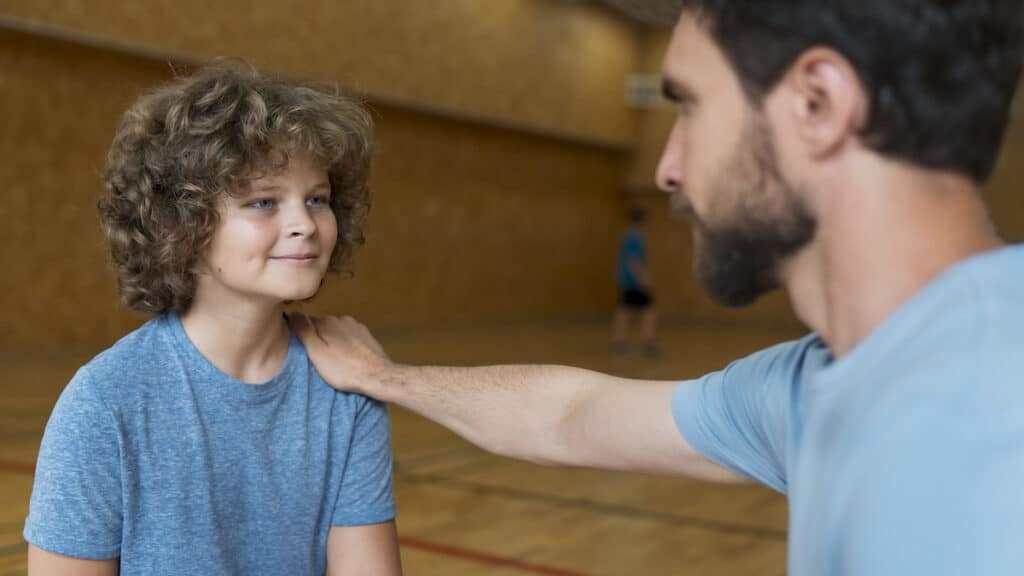As it is natural, children constantly try to assert their will and opinions as they navigate life. Learning how to parent a strong-willed child is, in many aspects, not easy. Yet, all behaviors, even negative ones, serve a purpose. For example, testing limits can be a way for children to see if boundaries still stand. Risky behavior and trying new things can come from a need to learn by experience. Getting into conflicts can be a way to make their opinions heard. By understanding the intentions behind the behavior, we, parents of determined, stubborn children, can respond to it more constructively.
1. Acknowledge: The First Step In Learning How to Parent a Strong-Willed Child
Let’s put it this way. Raising a strong-willed child is not an easy task. The discipline techniques for a strong-willed toddler have to support their inner drive and autonomy while pointing out the value of considering other people’s perspectives.
While you can try to force it, oppose it, and even bring a heavy arsenal of bribes and punishments to get them to listen, accepting your child’s nature is more constructive and it helps you to learn how to parent a strong-willed child.
As Jane Murray, a researcher at the University of Northampton, might put it: “Every child is unique, with individual needs and ways of learning which are recognized, appreciated and met and who is enabled to be confident, caring, valued, independent, motivated, supported, self-disciplined and respected.” Try working with your child’s individuality, not against it.

These children possess an independent spirit and an unrelenting desire to assert their autonomy. It is not uncommon for them to resist rules and authority, making traditional discipline techniques ineffective.
👉If you want to discover effective strategies to discipline and connect with your child, read the article: How Do You Discipline a Child That Won’t Listen? Learn how to navigate the challenges of a non-responsive child today!
2. Setting Clear Expectations and Boundaries In a Calm and Firm Manner
Setting clear expectations and boundaries is an essential aspect of effective parenting. It’s even more critical when you want to learn how to deal with a stubborn child. It helps children understand what is expected of them and what behaviors are acceptable. Clear expectations and boundaries also provide a sense of structure and routine, which can be comforting and reassuring for children. Involving your child in the process and asking for their input helps them feel included and valued.
The Power of Clear and Consistent Rule Enforcement
This teaches children that rules are not just suggestions but important guidelines that must be followed. Strong-willed kids become the greatest listeners when their input is considered and discussed. It’s better to present rules as being enforced until new, improved rules that everyone approves of arise.
Take Mary, for example. A mother of a six-year-old self-driven child named Tyler. She experienced this problem firsthand. Tyler often refused to follow rules and would become very angry and frustrated when told to do something he did not want to do—the vivid definition of a strong-willed child.
Mary tried various discipline techniques, including time-outs and taking away privileges, but nothing seemed to work. The biggest a-ha moment was when Mary discovered that Tyler’s strong-willed personality was not a problem but a strength.
She could reason with him on any other occasion, rather than the ones that required a fast response. She decided to implement a new discipline technique that would empower Tyler to make his own choices while also guiding him to consider the impact of his actions on others.

Mary started by setting clear expectations and rules for Tyler, but instead of punishing him for breaking them, she would talk to him about the consequences of his actions. For example, when Tyler refused to clean up his toys, Mary would explain how leaving them on the floor could be dangerous for his baby sister, who could trip and fall.
She would then give Tyler the autonomy to decide how and when to clean up his toys. The rule was that the toys needed to be put away before bedtime. A firm consequence was that if one of his toys became a danger or harmed his baby sister, it would have to go away.
Tyler responded positively to this new approach. He enjoyed having more control over his choices and became more responsible with his things. He would even take the initiative to clean up his toys without being prompted, knowing that it would help keep his sister safe.
3. Avoiding Power Struggles
A power struggle with a strong-willed child is something that would put any prime-time TV show out of business. It’s not only about requests and refusals; it’s a battle between forces – between right and wrong.
Spirited children are masters of digging their heels in and refusing to budge. They don’t give in easily, and their determination can be both a blessing and a curse. Parents can find themselves locked in a power struggle, fighting for control and sometimes feeling like they’ve hit a brick wall.
When facing a stubborn child, it’s essential to recognize that the traditional “my way or the highway” approach isn’t always effective. Instead, try to take a collaborative approach that empowers your child to make decisions while teaching them the importance of considering other people’s points of view.
For example, if your child insists on wearing mismatched clothes, let them express their individuality instead of demanding they change. A white flag approach may involve stepping back from the situation and allowing your child to feel in control. This technique works well when your child is set on doing something that’s not harmful or dangerous.
But what about when you’re facing a situation where safety is a concern, such as not wanting to wear a seatbelt? This is where a collaborative approach to setting limits can be beneficial.
Sit down with your child and explain why safety is important and why these rules are in place. Listen to their concerns and work together to find a solution that satisfies both of you. The autonomy support they get from you when carefully and consciously choosing your battles will come to your rescue when strictness is the only option.
4. Encourage Your Child’s Independence and Decision-Making Skills
The working with and not against approach we’ve discussed earlier. There are a lot of circumstances when it’s advised to let children have their way. Having a choice in what to wear doesn’t hurt anybody.
It even serves as a lesson for receiving feedback from others. While it’s not ok to become self-conscious because of others’ disapproval, the parent-child relationship should allow feedback to come from peers as a natural consequence.
Only then can the child choose to affirm a style or change it. We tend to be a bit over-protective of how our child appears to others, but this might rob them of valuable life lessons.

Encouraging Generosity and Independence: Nurturing Children’s Values and Safety
Remember that toy you bought for 90 bucks? Or that expensive designer shirt you bought for them to wear at your brother’s wedding? Your kid wants to give it to his best friend as a gift. While your first reaction might be to protect your investment, you could let them decide since it’s their property now.
Sharing and caring for others is a behavior that is usually learned from parents, caregivers, and other close attachment figures.
Now, talking about independence. A recent Safe Kids Worldwide survey on kids’ safety and injury prevention shows that parents’ main concern is that they won’t be able to protect their children from harm. We live with a constant fear of strangers, injuries, or that our children are not ready to make good decisions.
David wouldn’t let Max, his 8-year-old son, ride his bike to a nearby friend’s house alone. Being a strong-willed kid, Max thought his dad’s constant refusals would stop if he proved nothing bad could happen. Getting ready to hop on his bike and hit the road, he met his dad at the garage door. It was obvious to David what his son was doing.
To overcome this challenge and deal with his son’s drive to try this new thing, regardless of his advice, David started by setting clear boundaries and expectations for Max. He discussed the importance of following traffic rules, wearing a helmet, and staying on designated bike paths. David also rode the route with Max a few times to ensure he was comfortable with the path.
This approach gave Max the confidence to ride his bike on his own while also providing David with peace of mind that his son was safe. Max enjoyed the sense of independence and responsibility that came with riding his bike alone and became more confident in his abilities.

This is how to parent a strong-willed child and how to guide them toward making good decisions. Supporting your child’s independence while keeping them safe is possible with the right approach, one that works for your family and your child’s unique needs.
5. Respect Your Child’s Feelings and Needs
Some of us hold on to limits and rules too tightly. There’s one thing to be firm and consistent and another to withhold from adapting boundaries to the growing child’s needs and development.
Kids may sometimes have a hard time fitting into outdated limits and give signals when it’s time to change or improve them. Unfortunately, it doesn’t always look pretty. They fight, they resist, they push, and they pull to try to gain some control, dismissing most of your parenting techniques to get them to cooperate. Because sometimes you give in to these attempts, they reuse it whenever needed.
Take a Step Back and Listen to Your Son or Daughter
Are they overwhelmed by your rules, not feeling like they have any space to develop their identity? Do they need more independence? Are they struggling with low self-esteem or peer pressure to become someone else? Discuss and work together. Adjust boundaries if needed.
Share your concerns about safety if you have them and listen to their ideas. If you feel anxious, practice active listening. This means you will try to listen with an open mind and heart, don’t interrupt, and refrain from letting your mind create a comeback for every line.

Let’s say that your kid is pushing for more screen time. You know that you cannot agree to more because limiting time on devices is a family value. You could use the common cliché “Because I’m your parent and I say so!”.
However, it might be better to start with empathy and validate your child’s feelings “I understand that you want more time when using technology. The content is getting more interesting with each day passing, and technology is getting smarter and more attractive. I’m sure some friends of yours are allowed to have more screen time than you. We choose to limit our technology use because we are aware of the effects it has. And because we are an active family that enjoys spending a lot of time outdoors.”
You can also suggest activities for them to engage in during the screen-free time. This is one scenario, but it’s easily adaptable to any other situation.
👉 Ready to transform your parenting experience? Gain insights into why your kids don’t listen and find effective strategies to overcome this challenge. Find out more information in the article: Why My Kids Don’t Listen to Me.
Adapt Boundaries to Meet the Changing Needs and Development of Our Children
Seeing that your strong-willed child shares feelings and concerns, and staying open for discussion is a precious gift. A 2023 study developed by Vanderbilt University shows how important it is to understand how emotions and thoughts affect how parents raise their children and how they handle their kids’ feelings. It’s important because it can impact how children learn to deal with their own emotions.
As your child transitions to adolescence and then adulthood, this will strengthen your relationship and empower your child to make good decisions, considering your input.
6. Positive Reinforcement and Encouragement
Some parents have to admit that they are naturally more inclined to observe the negatives. Sometimes when we discipline our children and want to learn how to parent a strong-willed child, we tend to be more creative in pointing out what went wrong. Conversely, when the child is on his best behavior, we throw empty praise like “Bravo”, or “Well done” or even keep the good thoughts for ourselves so as not to spoil the child with too much attention.
From this, children may take the idea that good behavior and success are undervalued; hence, no need to put in the extra effort. Some might even engage intentionally in misbehavior to get their parent’s attention. Strong-willed children are usually the subjects of the most glorious meltdowns and temper tantrums.
To prevent attention-seeking negative behavior, honestly and specifically use praise to acknowledge the effort put in by your child. For example, you can say: “I saw how hard your homework was, but you did it anyway. I’m proud of you!” rather than the generic “Good job!”.

Encourage your child to express their feelings and auto-evaluate their performance. Help them come up with solutions to problems that arise. This can help prevent negative attention-seeking by giving your child the tools they need to handle challenging situations, making them more resilient and responsible.
7. Allow Your Child to Experience the Natural Consequences of Their Actions
Natural and logical consequences are useful discipline techniques for strong-willed children. Since they usually take their learnings from hands-on testing, natural consequences can put stubborn children back on track.
Natural consequences occur when a child experiences the natural outcome of their behavior without intervention from a parent. For example, if a child refuses to eat their dinner, they will be hungry later in the evening.
Logical consequences, on the other hand, are consequences that a parent sets in response to a child’s behavior. For instance, if homework is not finished the night before school, extra hours will be invested in the weekend to catch up. Or, if a child breaks a toy, they might not be able to play with it for a while as a result of their actions.
Conclusion
Learning how to parent a strong-willed child may be a challenge. By understanding the motivations behind their child’s behavior, parents can respond constructively and provide clear expectations and boundaries. Adapting these boundaries to meet their changing needs is also essential to their growth and development. Praising positive behavior and using natural and logical consequences are effective discipline techniques for strong-willed children. Lastly, parents’ concerns regarding their stubborn children’s independence can be addressed by empowering them to make good decisions.
Got everything you need on how to deal with a strong-willed child? Ready to enhance your parenting skills and create meaningful connections with your child? Join our empowering online masterclass, ‘How to Talk so Kids Will Listen: 3 Proven Methods.’ Discover effective strategies for fostering open communication and building a strong parent-child bond. Don’t miss out on this valuable opportunity – enroll now and embark on a journey of positive parenting!”
References
Bailes, L. G., Ennis, G., Lempres, S. M., Cole, D. A., & Humphreys, K. L. (2023). Parents’ emotion socialization behaviors in response to preschool-aged children’s justified and unjustified negative emotions. PLOS ONE, 18(4), e0283689. https://doi.org/10.1371/journal.pone.0283689
Bølstad, E., Havighurst, S. S., Tamnes, C. K., Nygaard, E., Bjørk, R. F., Stavrinou, M., & Espeseth, T. (2021). A Pilot Study of a Parent Emotion Socialization Intervention: Impact on Parent Behavior, Child Self-Regulation, and Adjustment. Frontiers in Psychology, 12. https://doi.org/10.3389/fpsyg.2021.730278
Cummings, E. M., Schermerhorn, A. C., Davies, P. T., Goeke-Morey, M. C., & Cummings, J. S. (2006). Interparental Discord and Child Adjustment: Prospective Investigations of Emotional Security as an Explanatory Mechanism. Child Development, 77(1), 132-152. https://doi.org/10.1111/j.1467-8624.2006.00861.x
Damian, R. I., & Roberts, B. W. (2015). The associations of birth order with personality and intelligence in a representative sample of U.S. high school students. Journal of Research in Personality, 58, 96-105. https://doi.org/10.1016/j.jrp.2015.05.005
Davies, P. T., & Woitach, M. J. (2008). Children’s Emotional Security in the Interparental Relationship. Current Directions in Psychological Science. https://doi.org/10.1111/j.1467-8721.2008.00588.x
Dennis, T. A., Hong, M., & Solomon, B. (2010). Do the associations between exuberance and emotion regulation depend on effortful control? International Journal of Behavioral Development. https://doi.org/10.1177/0165025409355514
Francis, J., Martin, K., Wood, L., & Foster, S. (2017). ‘I’ll be driving you to school for the rest of your life’: A qualitative study of parents’ fear of stranger danger. Journal of Environmental Psychology, 53, 112-120. https://doi.org/10.1016/j.jenvp.2017.07.004
Jane Murray (2019) Hearing young children’s voices, International Journal of Early Years Education, 27(1), 1-5, https://doi.org/10.1080/09669760.2018.1563352
Jin, Z., Zhang, X., & Han, Z. R. (2017). Parental Emotion Socialization and Child Psychological Adjustment among Chinese Urban Families: Mediation through Child Emotion Regulation and Moderation through Dyadic Collaboration. Frontiers in Psychology, 8. https://doi.org/10.3389/fpsyg.2017.02198
Kets de Vries, Manfred F.R., (2018). I Won’t, Therefore I Am: Being Stubborn. INSEAD Working Paper, 42. http://dx.doi.org/10.2139/ssrn.3253106
Menting, A. T., Orobio de Castro, B., & Matthys, W. (2013). Effectiveness of the Incredible Years parent training to modify disruptive and prosocial child behavior: A meta-analytic review. Clinical Psychology Review, 33(8), 901-913. https://doi.org/10.1016/j.cpr.2013.07.006
National Academies of Sciences, Engineering, and Medicine; Division of Behavioral and Social Sciences and Education; Board on Children, Youth, and Families; Committee on Supporting the Parents of Young Children (2016). Parenting Matters: Supporting Parents of Children Ages 0-8. National Academies Press Parenting Knowledge, Attitudes, and Practices. https://www.ncbi.nlm.nih.gov/books/NBK402020/
Nieman, P., Shea, S., Society, C. P., & Committee, C. P. (2004). Effective discipline for children. Paediatrics & Child Health, 9(1), 37-41. https://doi.org/10.1093/pch/9.1.37
Safe Kids Worldwide. (2022). National Parent Survey on Child Injury – Parents’ Attitudes, Beliefs, and Behaviors Related to Key Causes of Unintentional Childhood Injury. https://www.safekids.org/sites/default/files/documents/2022_skw_national_parent_survey.pdf
Sanders, W.M. (2011). Parental Emotion Socialization and its Associations to Internalizing Symptoms: The Influence of Parent Gender and Emotion Understanding. Dissertations, Theses, and Masters Projects. https://dx.doi.org/doi:10.21220/s2-nhyn-t490
Saracho, O.N. (2023). Theories of Child Development and Their Impact on Early Childhood Education and Care. Early Childhood Education Journal, 51, 15–30. https://doi.org/10.1007/s10643-021-01271-5
Trautner, T. (2016). Benefits of a strong-willed child. Michigan State University Extension. https://www.canr.msu.edu/news/benefits_of_a_strong_willed_child
Zero to Three. (2016). National Parent Survey Overview and Key Insights. https://www.zerotothree.org/resource/national-parent-survey-overview-and-key-insights/











